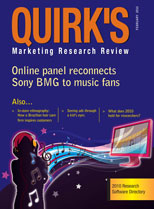Editor's note: Ted Mininni is president of Design Force Inc., a Marlton, N.J., brand design consultancy. This article appeared in the February 22, 2010, edition of Quirk's e-newsletter.
Packaging isn't a one-off marketing initiative existing in a vacuum. In fact, packaging has been under-utilized as a driver for connectivity with today's highly-interactive kids. They're on the computer, texting on cell phones and playing video games, so kids' packaging should tie neatly into those vehicles. But how can it be made more interactive? Simply printing a Web address on the back or side panel of packaging isn't sufficient. A device that is part of package design but is clearly visible with the most casual observation can create curiosity and spark interest. A packaging add-on that invites interaction via a company Web site, texting opportunities, gaming or membership into a special club can initiate developing the all-important relationship between kids and brands.
So what does a packaging device that encourages interactivity look like in the real world? Structure, color, imagery and copy have to come together effectively if packaging is going to deliver the brand and its promise and connect with elusive youth. Consider the following:
- adding a plastic "club membership" card that is easily removed from the packaging with the Web address embedded on it;
- including a small plastic toy or brand icon on the package that can be added to kids' key chains or backpacks (or perhaps making it magnetic?);
- creating a pressure-sensitive label in the shape of the brand logo - on clamshell packaging, this logo could be die-cut and bumped out, making kids gravitate to it;
- utilizing packaging to give kids fun reasons to come to a site loaded with games and adventure;
- suggesting kids bring their friends into the games via text messaging;
- asking kids to sign up on the Web site to test a new product or new flavor or vote on proposed new line extensions; and
- soliciting their feedback on products they've already purchased and asking them what kinds of products would they like to buy.
What innovative product ideas might emerge from these kinds of initiatives for marketers?
Increasingly interactive
Smart kids' brands have become increasingly interactive. They've grown in volume, and more importantly, mind-share as a result. Here a few real-world examples of companies that are at the forefront of the interactive packaging trend.
Neopets - Nickelodeon and Viacom's online community for kids - boasts millions of global memberships with its virtual pets, games and activities. When Nickelodeon and Viacom Consumer Products launched Neopets plush, it was an immediate success. Trading cards, toys and games were subsequently added to the line and packaged to create a product-to-Web experience. Unique codes on packaging drive kids to the Neopets Web community for a 360-degree experience. Neopets product packaging contains key codes, allowing kids to unlock virtual game pieces, representing characters. These add-ons tie into a multiplayer gaming and collecting experience. Kids who aren't part of the Neopets site are invited to join when purchasing a toy.
Lego ties its consumer-facing marketing components together expertly. Even though kids and their parents can purchase Lego sets from Lego's own stores as well as large retailers, the largest selection is available directly from Lego's own Web site and shop-at-home catalog. Once online, kids can go to legofactory.com to create Lego models online, share them with their friends and purchase their customized sets to make the creation themselves. Some of Lego's most popular products are tied into licensed properties on the Web site. The site's Indiana Jones section, for example, includes product packaging that features an online game, video game and mini movie. Additional products are also cleverly featured to build multiple sales.
Happening at warp speed
Forging relationships, alliances and exchanging ideas are all happening at warp speed thanks to new communications platforms and social media. By providing additional impetus for interaction, packaging can create a more vital link between brands and kids. Great ideas can be solicited when kids connect and communicate more closely with companies. If kids are treated as valued, respected consumers whose ideas matter, they will feel empowered. They will become evangelists and spread the love and coolness factor for the brand among their peers. We all understand the value of word of mouth when it comes to brands, and the importance of brand evangelism can hardly be overstated when it comes to kids.
